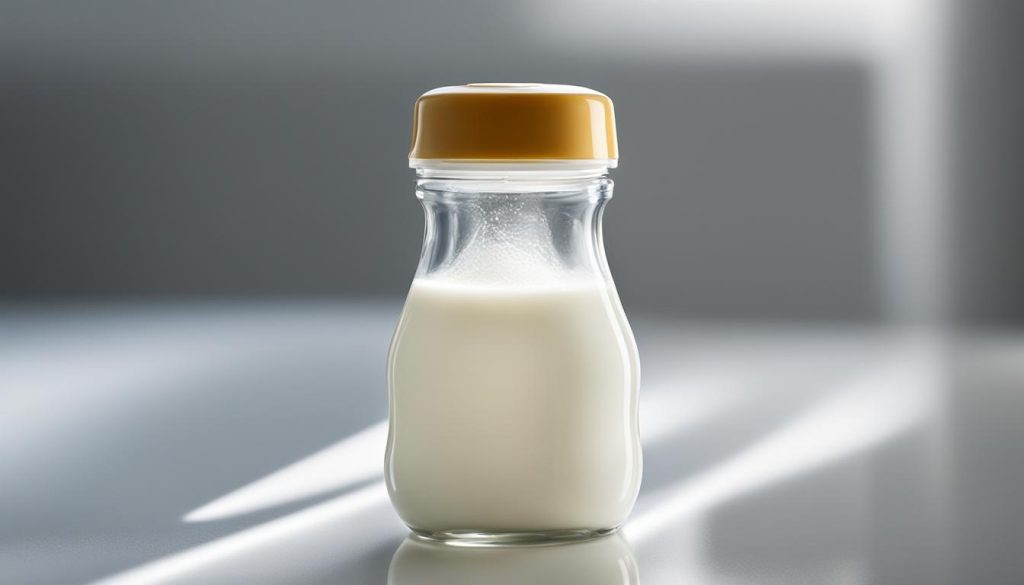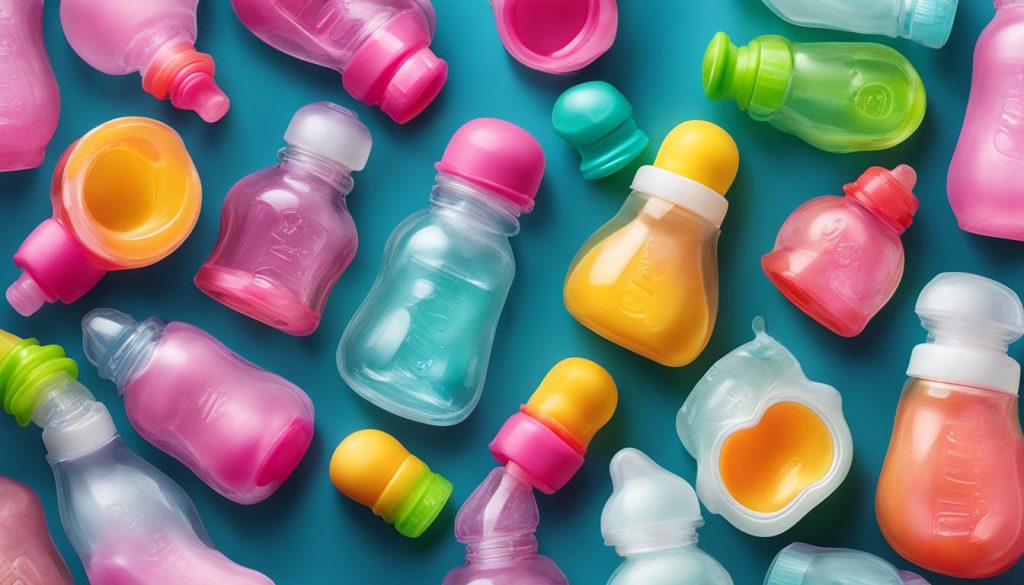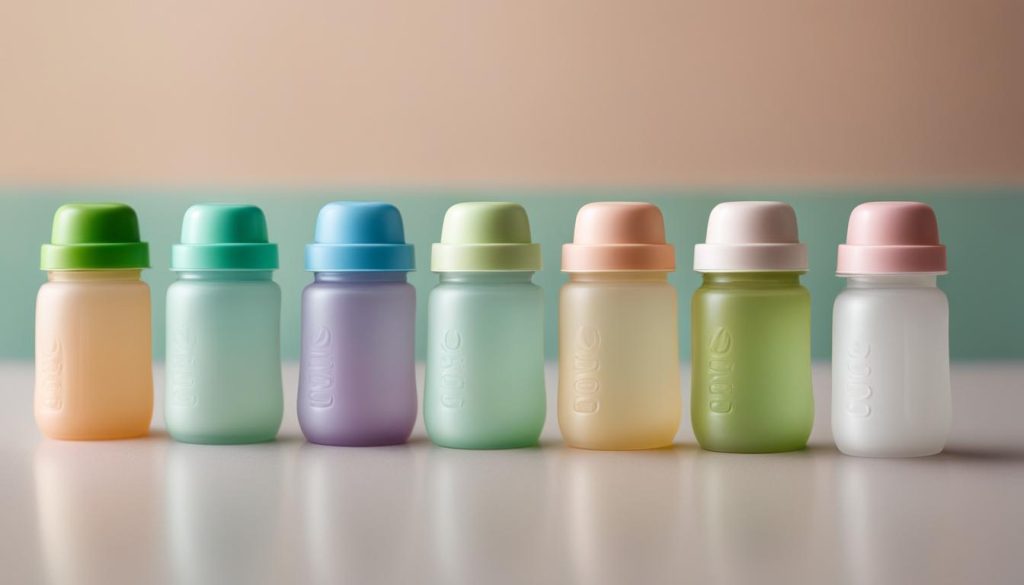As a new parent, providing a safe and comfortable feeding experience for your newborn is of utmost importance. That’s why choosing the right slow flow bottles is crucial in ensuring your baby’s well-being. Slow flow bottles for newborns, also known as newborn feeding bottles or baby bottles for slow flow, are specifically designed to meet the unique needs of your little one.
When it comes to slow flow bottles, Dr. Talbot’s is a trusted brand that offers a range of options to cater to every stage of your baby’s feeding journey. Their bottles prioritize sterilization made simple, ensuring a hygienic feeding environment. With safe and non-toxic materials, easy latch nipples, and anti-colic features, Dr. Talbot’s bottles provide the perfect balance between comfort and functionality.
Parents who have chosen Dr. Talbot’s bottles have reported positive feedback, noting improved colic symptoms and a smooth transition between breastfeeding and bottle-feeding. By investing in the best slow flow bottles for your newborn, you can ensure a safe and enjoyable feeding experience for both you and your baby.
Types of Baby Bottles for Slow Flow
When it comes to choosing the right baby bottle for your newborn, there are several options available. Understanding the different types of bottles can help you make an informed decision based on your baby’s needs and your own preferences.
Glass Baby Bottles
One popular choice is glass baby bottles. These bottles are known for their durability and ease of cleaning. They are made from high-quality, tempered glass that is resistant to cracking and shattering. Glass bottles are also free from harmful chemicals, providing a safe and healthy option for your baby. Additionally, they do not absorb odors or flavors from previous feedings, ensuring that each meal is fresh and enjoyable for your little one.
Plastic Baby Bottles
Another common option is plastic baby bottles. These bottles are lightweight, making them easy to handle and carry around. They are also more affordable compared to glass bottles. However, it is important to choose BPA-free plastic bottles to ensure the safety of your baby. BPA, or bisphenol A, is a chemical commonly found in plastics that can leach into the contents of the bottle and may have negative health effects. Opting for BPA-free plastic bottles can provide peace of mind for parents.
Silicone Baby Bottles
Silicone baby bottles are gaining popularity among parents due to their soft and flexible material. These bottles are easy to grip and are often designed with anti-colic features, reducing the amount of air your baby ingests during feeding. Silicone bottles are also free from toxins and are a safe choice for your little one. The soft texture of silicone nipples closely resembles the feel of a mother’s breast, making it easier for babies to latch on and transition between breastfeeding and bottle-feeding.
To help you better understand the differences between these types of bottles, here is a comparison table:
| Types of Baby Bottles | Advantages | Disadvantages |
|---|---|---|
| Glass Baby Bottles | Durable, easy to clean, free from harmful chemicals | Heavier than plastic bottles |
| Plastic Baby Bottles | Lightweight, affordable | Potential risk of BPA exposure if not BPA-free |
| Silicone Baby Bottles | Soft, flexible, easy to grip, mimic breastfeeding | May be more expensive than plastic bottles |
Ultimately, the choice of baby bottle material depends on your personal preferences, budget, and safety concerns. It is important to consider factors such as durability, ease of cleaning, and the absence of harmful chemicals when making your decision. Consulting with your pediatrician or other parents can also provide valuable insights into which type of bottle may be best suited for your baby’s needs.
Next, we will explore the importance of slow flow bottles in infant feeding and the benefits they provide for your little one’s overall well-being.
Importance of Slow Flow Bottles in Infant Feeding
Infant feeding is a critical aspect of a baby’s early development, and choosing the right bottle is essential for ensuring a safe and comfortable feeding experience. Slow flow bottles, specifically designed for newborns, play a crucial role in promoting healthy feeding habits and preventing common issues such as nipple confusion, gas, and discomfort. These bottles are designed to mimic the natural breastfeeding experience, allowing babies to control the flow of milk and preventing overfeeding.
One of the key benefits of slow flow bottles is that they help reduce the risk of nipple confusion. Newborns who are transitioning from breastfeeding to bottle-feeding may struggle with different nipple shapes and flow rates. Slow flow bottles have nipples specifically designed to resemble the natural breast, making it easier for babies to latch and feed comfortably. This smooth transition between breast and bottle can help maintain breastfeeding relationships while providing parents with more flexibility in feeding their little ones.
In addition to preventing nipple confusion, slow flow bottles also have various other benefits. They help reduce gas and colic by minimizing the amount of air swallowed during feeding, leading to a more comfortable feeding experience for babies. Slow flow bottles also promote better digestion and can reduce spit-up, ensuring that babies receive the nourishment they need without any unnecessary discomfort. By using slow flow bottles, parents can provide their newborns with a safe and enjoyable feeding experience while promoting proper growth and development.
Comparison of Materials Used in Baby Bottles
When it comes to choosing a baby bottle, it’s essential to consider the materials used. Different materials offer various benefits and features that cater to the needs of both parents and babies. Let’s take a closer look at the comparison of bottle materials – glass vs plastic bottles – and the importance of choosing BPA-free baby bottles with safe silicone nipples.
Glass Baby Bottles
Glass baby bottles have been a popular choice among parents for their durability, ease of cleaning, and safety. Glass is a non-porous material that doesn’t absorb odor or color from liquids, ensuring a clean and hygienic feeding experience. These bottles are also free from harmful chemicals like BPA, phthalates, and PVC, making them a safe choice for newborns. Additionally, glass baby bottles are known for providing a natural and consistent temperature for milk, preserving essential nutrients. Although they may be slightly heavier and more expensive, glass bottles are a preferred option for parents who prioritize safety and sustainability.
Plastic Baby Bottles
Plastic baby bottles are lightweight, affordable, and widely available in the market. However, it’s crucial to choose BPA-free options to ensure the baby’s safety. Bisphenol A (BPA) is a chemical commonly found in some plastics and has been linked to potential health risks. BPA-free plastic bottles are made from polypropylene or polyethylene, which are considered safe for use. These bottles are resistant to breakage and are an excellent choice for parents who prefer a lighter and more budget-friendly option. It’s important to note that plastic bottles may show signs of wear and tear over time and should be replaced periodically to maintain hygiene and safety.
Silicone Nipples
Choosing the right nipple material is equally important when selecting a baby bottle. Silicone nipples are a popular choice for their soft, flexible texture that closely mimics the natural feel of the breast. They are free from harmful toxins like latex and phthalates, ensuring a safe and comfortable feeding experience for newborns. Silicone nipples are also known for their durability, resistance to temperature changes, and ease of cleaning. They come in various shapes and sizes, allowing parents to select the most suitable nipple for their baby’s feeding preferences. Whether it’s a wide-shaped nipple to encourage proper latch or a vented nipple to reduce colic, silicone nipples provide a reliable and safe option for bottle-feeding.
| Material | Benefits | Considerations |
|---|---|---|
| Glass | Durable, easy to clean, safe, non-porous | Heavier, more expensive |
| Plastic | Lightweight, affordable, widely available | Choose BPA-free options, may show signs of wear |
| Silicone Nipples | Soft, flexible, mimics natural feel of breast | Choose appropriate shape and size for baby’s preference |
When selecting baby bottles, parents should consider their preferences, budget, and safety concerns. Glass bottles offer durability and safety, while BPA-free plastic bottles provide a lightweight and affordable option. Silicone nipples ensure a comfortable feeding experience that closely resembles breastfeeding. By understanding the comparison of bottle materials and choosing the right combination, parents can make an informed decision and ensure their baby’s well-being during feeding time.
Types of Slow Flow Bottle Nipples
Choosing the right slow flow bottle nipple is essential for a comfortable and stress-free feeding experience for your newborn. There are different types of bottle nipples available, each with its own unique features and benefits. Here are some common types of slow flow bottle nipples:
1. Standard Nipples
Standard nipples are the most commonly used and come in various sizes to accommodate different flow rates. They have a round shape and a small hole at the tip, allowing a slow and steady flow of milk. Standard nipples are a great option for newborns who are just starting to bottle-feed.
2. Wide Nipples
Wide nipples resemble the shape of a mother’s breast, making it easier for babies to latch on. They have a broader base and a wider nipple, providing a more natural feeding experience. Wide nipples are especially beneficial for breastfed babies transitioning to bottle-feeding, as they help minimize nipple confusion.
3. Anti-Colic Nipples
Anti-colic nipples feature a venting system that helps reduce the intake of air during feeding, minimizing the risk of colic and gas. These nipples have special vents or valves that allow air to flow freely, preventing the formation of air bubbles in the milk. Anti-colic nipples are recommended for babies who are prone to gas and fussiness.
When selecting a slow flow nipple, it’s important to consider your baby’s feeding style and preferences. Some babies may prefer a certain shape or material, while others may need a nipple that mimics breastfeeding more closely to prevent nipple confusion. By choosing the right slow flow nipple, you can ensure a smooth and comfortable feeding experience for both you and your baby.
Table: Comparison of Slow Flow Bottle Nipples
| Nipple Type | Features | Recommended for |
|---|---|---|
| Standard Nipples | Round shape, small hole for slow flow | Newborns, babies starting to bottle-feed |
| Wide Nipples | Resemble the shape of a mother’s breast | Breastfed babies transitioning to bottle-feeding |
| Anti-Colic Nipples | Venting system to reduce air intake | Babies prone to colic and gas |
Tips for Bottle Maintenance and Sterilization for New Parents
Proper bottle maintenance and sterilization are essential for maintaining a clean and hygienic feeding environment for newborns. As a new parent, it’s important to follow these bottle maintenance tips and best practices to ensure the health and safety of your baby.
Bottle Maintenance Tips
To keep your baby bottles in optimal condition, always wash them thoroughly after each use. Use warm soapy water and a bottle brush to clean the bottles, nipples, and any other accessories. Pay special attention to the nooks and crannies where milk residue can accumulate.
After washing, rinse the bottles and nipples with clean water to remove any soap residue. Inspect them carefully for any signs of wear or damage, such as cracks or scratches. If you notice any damage, it’s best to replace the bottle or nipple to ensure your baby’s safety.
Bottle Sterilization
Sterilizing baby bottles is crucial to eliminate harmful bacteria and provide a hygienic feeding experience. There are several methods of sterilization you can choose from:
– Self-sterilizing: Some bottles are designed to be sterilized in the microwave with a small amount of water. Follow the manufacturer’s instructions for the correct sterilization process.
– Boiling: Place the bottles and nipples in a pot of boiling water for at least 5 minutes. Make sure they are completely submerged. Avoid overcrowding the pot to ensure effective sterilization.
– Steam sterilization: You can use an electric steam sterilizer that uses hot steam to kill bacteria. This method is convenient and efficient.
– Chemical sterilizing solutions: There are sterilizing solutions available in the market that can be used to soak the bottles and nipples. Follow the instructions provided by the manufacturer to ensure proper sterilization.
Remember to wash the bottles and nipples thoroughly before sterilization to remove any milk residue. After sterilization, store the bottles in a clean and dry place, preferably covered to protect them from dust and dirt.
By following these bottle maintenance and sterilization tips, you can provide a safe and hygienic feeding environment for your little one. Regularly inspect and replace worn-out bottles or nipples to ensure your baby’s health and well-being.
FAQ
Are slow flow bottles necessary for newborns?
Yes, slow flow bottles are crucial for newborns as they allow babies to control the amount of milk they drink and prevent nipple confusion. They also help reduce gas, spit-up, and colic, providing a more comfortable feeding experience.
Which brand offers reliable slow flow bottles for newborns?
Dr. Talbot’s is a trusted brand that offers sterilization made simple, bottles for every stage, safe and non-toxic materials, easy latch nipples, and anti-colic features.
What are the benefits of using Dr. Talbot’s slow flow bottles?
Parents have reported positive feedback on using Dr. Talbot’s bottles, with improved colic symptoms and easy transition between breastfeeding and bottle-feeding.
What are the different types of baby bottles for slow flow?
There are three main types: glass baby bottles, plastic baby bottles, and silicone baby bottles.
What are the advantages of glass baby bottles?
Glass baby bottles are durable, easy to clean, and free from harmful chemicals.
Are plastic baby bottles a good choice?
Plastic baby bottles are lightweight and more affordable, but it’s important to choose BPA-free options to ensure the baby’s safety.
Why are silicone baby bottles popular?
Silicone baby bottles are soft, flexible, and easy to grip. They are also free from toxins and are a great option for parents looking for a safe and non-toxic bottle material.
Why are slow flow bottles important for infant feeding?
Slow flow bottles play a crucial role in infant feeding, especially for newborns who have small tummies and need to control the amount of milk they consume. These bottles help prevent nipple confusion and promote a smooth transition between breastfeeding and bottle-feeding.
What are the different shapes and features of slow flow bottle nipples?
Slow flow bottle nipples come in different shapes and sizes, some mimic the shape of a mother’s breast, while others have a venting system to reduce colic and gas.
How should I choose a slow flow nipple?
It’s important to choose a slow flow nipple that matches the baby’s feeding style and preferences. Avoiding nipple confusion is crucial, so it’s best to use slow flow nipples that closely resemble breastfeeding to ensure a smooth transition between breast and bottle-feeding.
How do I properly maintain and sterilize baby bottles?
Proper bottle maintenance and sterilization are essential for maintaining a clean and hygienic feeding environment for newborns. There are several methods of sterilization, including self-sterilizing with water and a microwave, boiling, steam sterilization, and chemical sterilizing solutions. It’s important to wash bottles and nipples thoroughly before sterilization and store them in a clean and dry place.




